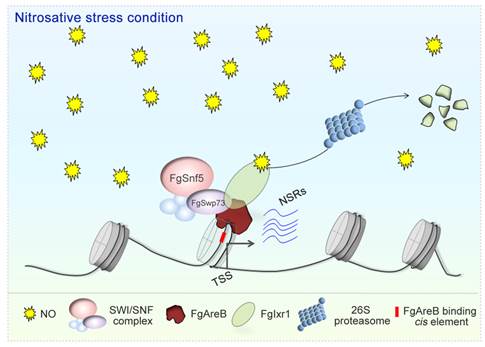Role of FgAreB in regulating fungal nitrosative stress response
The research team led by Prof. MA Zhonghua at the Zhejiang University College of Agriculture & Technology recently published an article entitled “Interplay of two transcription factors for recruitment of the chromatin remodeling complex modulates fungal nitrosative stress response” in the journal Nature Communications. This study reveals a new mechanism by which Fusarium graminearum (Fg) regulates nitrosative stress (NS), which facilitates a more insightful understanding of fungal response to external stresses and lays a theoretical foundation for the development of new methods for disease control.
Due to global warming, straw return and changes in farming practices, wheat Fusarium head blight (WFHB) caused by Fg has exhibited a resurgence in China in the last few years. This plague has not only led to tremendous losses in crop yields but also brought about poisoning to human and animal by fungal toxins, such as deoxynivalenol (DON). It has attracted immense attention because of its pervasive and debilitating effects and the difficulty in prevention and control of this disease. In 2020, the Ministry of Agriculture and Rural Affairs classified WFHB as a Class-I crop disease and pest.

Prof. MA Zhonghua’s team found that host could produce nitric oxide (NO) which would give rise to nitrosative stress (NS) to pathogen during infection. Therefore, the fungus must respond effectively to NS to infest host successfully. To analyze the molecular mechanism by which the pathogen responds to NS, researchers identified FgAreB as a pioneer transcription factor for the recruitment of the chromatin-remodeling complex SWI/SNF at the promoters of genes involved in the NS response, thus promoting their transcription. Furthermore, they also found that a transcription repressor (FgIxr1) competes with the SWI/SNF complex for FgAreB binding and negatively regulates the NS response. NS, in turn, promotes the degradation of FgIxr1, thus enhancing the recruitment of the SWI/SNF complex by FgAreB.